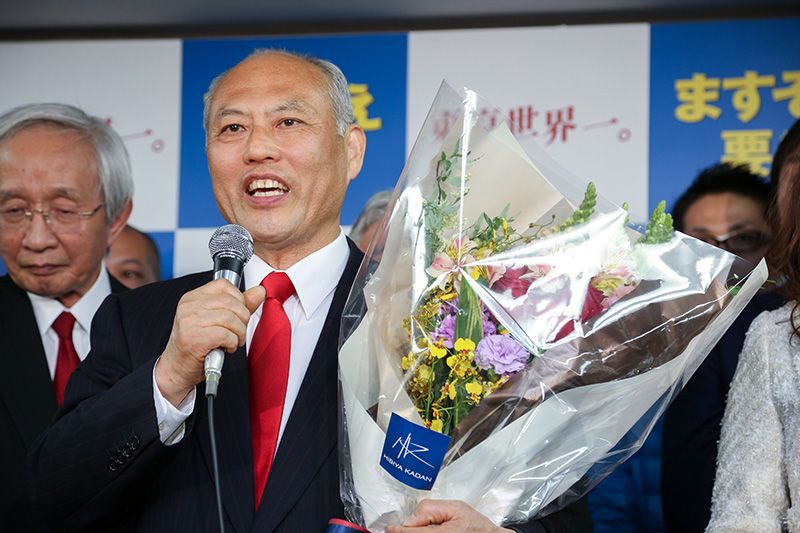
Masuzoe Yōichi: Tokyo’s Next Governor
Politics- English
- 日本語
- 简体字
- 繁體字
- Français
- Español
- العربية
- Русский
On February 9, 2014, Tokyo voters trudged to the polls through deep snow. There they elected Masuzoe Yōichi, a former member of the House of Councillors who served several terms as minister of health, labor, and welfare, to be the metropolis’s next governor.
Backed by the Liberal Democratic Party and New Kōmeitō, Masuzoe handily beat his main opponents in the contest: Hosokawa Morihiro, a former prime minister who ran on an anti-nuclear-power platform with the backing of another former premier, the popular Koizumi Jun’ichirō; and Utsunomiya Kenji, a former head of the Japan Federation of Bar Associations backed by the Japanese Communist Party and Social Democratic Party. The field of 16 candidates also included Tamogami Toshio, the right-wing former chief of staff of the Air Self-Defense Force.
Masuzoe becomes the eighth governor in Tokyo’s postwar history, and will serve a four-year term. He replaces Inose Naoki, who left office on December 24, 2013, after tendering his resignation in a money scandal after just a year in office.
Defeat for the Prime Ministerial “Tag Team”
Former Prime Minister Hosokawa would have been a high-profile candidate in any case, but he gained even more attention with Koizumi at his side, offering his full support to the Hosokawa call for a nuclear-free Japan. In the end, though, his relentless focus on the nuclear power issue gained him little traction among the roughly 30% of self-reporting independent voters in a metropolis that faces a host of issues viewed by the electorate as more urgent.
More importantly, perhaps, Hosokawa split much of the antinuclear vote with Utsunomiya, who ended up in second place in the polls on the strength of his grassroots support and focus on social issues in addition to the nation’s energy mix. Utsunomiya, who also came in second in the 2012 election that sent Inose to the governor’s office, said he was pleased with the strength of the support he sensed among voters this time.
Also looking ahead with more optimism is Tamogami, who received support from fellow conservative Ishihara Shintarō, a former governor of Tokyo. The ex-ASDF officer stated that his fourth-place finish has inspired him to build a conservative political party.
Masuzoe On Top in Limited Voting
The victorious Masuzoe, meanwhile, campaigned on a three-plank platform: preparing the capital to successfully host the 2020 Olympic and Paralympic Games, enhancing disaster preparedness to make the capital better able to withstand a strong earthquake with a nearby epicenter, and bolstering metropolitan social policy, including nursing care, preschool facilities, and employment measures. This approach meshed nicely with voter concerns, which polls showed to be medical and welfare systems, disaster readiness, economic and employment issues, crime and security, and other issues related to life and livelihood.
 A victorious Masuzoe addresses his supporters as results become clear. (Photo: Aflo)
A victorious Masuzoe addresses his supporters as results become clear. (Photo: Aflo)
On energy issues, Masuzoe did note during the campaign period that he had also long called for weaning Japan off of nuclear power—if not so swiftly as the other candidates would prefer—but that this was in the end a matter to be decided at the national level, not by Tokyo on its own.
Masuzoe’s victory came with support from the LDP and Kōmeitō, but this was not without controversy. He left the Liberal Democrats in 2010 to form the New Renaissance Party, criticizing his former party as one whose mission had ended. This produced debate within the LDP on whether to support Masuzoe in the election this time. Koizumi Shinjirō, the son of Jun’ichirō who now holds his father’s old seat in the House of Representatives, opposed the party decision to back its former member: “This is a man who left our party when it was facing its toughest times, saying ‘the LDP’s historical mission is finished.’ There’s no good reason to support him now.”
The heaviest snow in 20 years fell on Tokyo on Saturday, impacting voter turnout the following day. In the end just 46.14% of eligible voters cast ballots, a considerable drop from the 62.6% figure for the previous gubernatorial contest in December 2012 and the third-lowest turnout ever for a Tokyo governor election.
Masuzoe Yōichi
Born in Fukuoka Prefecture in 1948. After earning his political science degree from the University of Tokyo in 1971, became an academic assistant there in the same year. He went on to study as a research fellow at the University of Paris and the University of Geneva before returning to the University of Tokyo as an associate professor. Fluent in English and French, he built on his career as an international political scientist to become a popular commentator and media figure. In 1989 he left the university to establish the Masuzoe Institute of Political Economy. He served as an editorial board member for Japan Echo and editor in chief of Cahiers du Japon, both published by Japan Echo Inc., the predecessor of the Nippon Communications Foundation.
In 1999 he ran for governor of Tokyo, coming in third. In 2001 he won a proportional representation seat in the House of Councillors with the highest number of ballots of any candidate. He served two terms in the upper house through 2013. Beginning in 2007 he was minister of health, labor, and welfare in the short-lived administrations of Abe Shinzō, Fukuda Yasuo, and Asō Tarō. In 2010 he left the LDP to launch the New Renaissance Party, which he headed through July 2013. In February 2014 he was elected governor of Tokyo.
Top Candidates, 2014 Tokyo Governor Election
| 1 | Masuzoe Yōichi (65) | 2,112,979 votes (Independent; backed by LDP, Kōmeitō) |
| 2 | Utsunomiya Kenji (67) | 982,594 (Independent; backed by JCP, SDP) |
| 3 | Hosokawa Morihiro (76) | 956,063 (Independent) |
| 4 | Tamogami Toshio (65) | 610,865 (Independent) |
Voter turnout: 46.14%